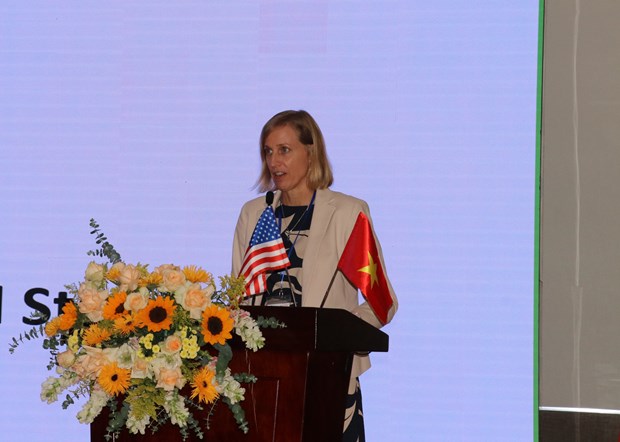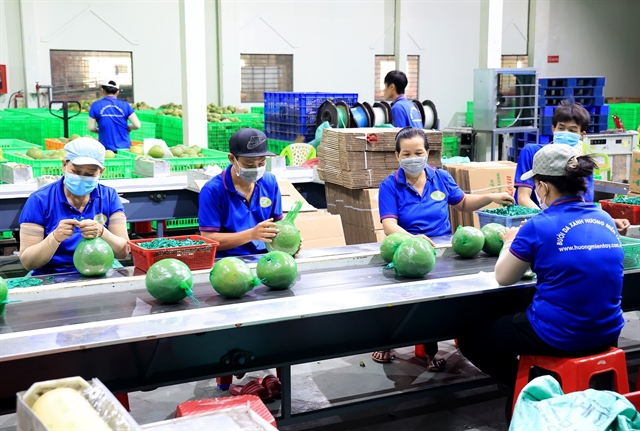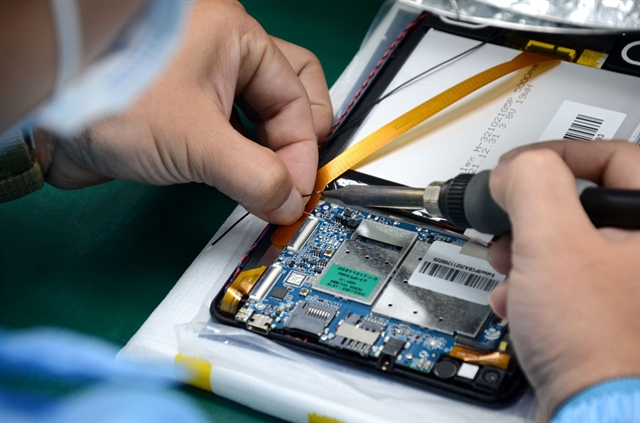 Economy
Economy

 |
| FEELING FRUITY: A packaging line for green-skinned pomelos in Mỏ Cày Bắc District, Bến Tre Province. The first batch of Bến Tre green-skinned pomelos was exported to the US in October 2022. VNA/VNS Photos |
By Ly Ly Cao
Additional report by Bảo Hoa
One year following the advancement of the Việt Nam-US relationship into a Comprehensive Strategic Partnership, bilateral collaboration has flourished across essential domains, notably in economy and technology, yielding mutual advantages for both nations.
The historic elevation of Việt Nam-US relationship was announced by late Party General Secretary Nguyễn Phú Trọng and President Joe Biden on September 10, 2023, during the latter's official visit to Việt Nam.
After a year, the two countries’ economic relationship remains strong, forward-looking and positive, with numerous high-level reciprocal visits between delegations from the two countries.
The US continues to be Việt Nam’s largest export market, while Việt Nam has ascended to become the eighth largest trading partner of the US, and the foremost trading ally within the ASEAN region.
Notably, it stands as the sixth biggest importer of goods for the US.
Bilateral trade volume has been steadily increasing at an average rate of around 16 per cent per year.
In the first eight months of the year, two-way trade turnover surged to almost US$88 billion, marking a substantial 22 per cent increase from 2023, statistics from the Ministry of Industry and Trade (MoIT) showed.
Particularly, Việt Nam’s exports to the US reached $77.9 billion, up 24.5 per cent from the previous year, while imports from the US amounted to $9.8 billion, reflecting a 5.3 per cent uptick.
A significant milestone is the US's newfound status as the primary export market for Việt Nam’s agricultural and aquatic products, with a turnover of $8.58 billion in the first eight months of this year, constituting 21.4 per cent of the total.
Recently, Alexis Taylor, undersecretary of the US Department of Agriculture (USDA), led the largest agricultural trade delegation ever to Việt Nam, bringing representatives from 50 businesses and nine states’ departments of agriculture to mark the first anniversary of Việt Nam-US Comprehensive Strategic Partnership.
In June, US Ambassador to Việt Nam Marc Knapper led a record 65-strong delegation of Vietnamese businesses to the SelectUSA Investment Summit in Washington, DC.
The first Comprehensive Strategic Partnership Economic Dialogue, which was a new forum to discuss economic and policy cooperation, was also held in June. The US Mission to Vietnam, through USAID, is supporting Việt Nam’s growing digital economy, through an MoU signed with the MoIT for a US$3.2 million new programme focused on digital trade.
USAID also launched a partnership with Agribank and VPBank to expand finance opportunities for small and growing enterprises in the agriculture sector.
“In the past, it was common for government-level delegations, such as the USDA and the Việt Nam Ministry of Agriculture and Rural Development (MARD), to meet for discussions, negotiations, and exchanges. Now, we witness delegations from state and local agricultural departments, business associations and most recently, a group of American female farmers, visiting and collaborating to share insights with Vietnamese farmers,” Nguyễn Đỗ Anh Tuấn, director of the Department of International Cooperation under MARD, told Việt Nam News.
“These examples epitomise the deepening bonds within the Comprehensive Strategic Partnership between Việt Nam and the US in agriculture.”
Tuấn also said that Việt Nam had exported nine types of fruit to the US. Both parties were now actively pushing to further open the US market for Vietnamese dragon fruit, in return Việt Nam approved in August the import of California nectarines and peaches.
“Soon, there will be a wider array of fruits available for trade between the US and Việt Nam. For instance, the US market has shown interest in seedless limes, jackfruit and guava from Việt Nam,” Tuấn added.
The US market, being vast and diverse with strong growth potential, would provide an excellent opportunity for distinctive tropical products that are native to Việt Nam and not commonly found in the US.
This would leave more room for Vietnamese enterprises. However, Tuấn warned businesses wishing to expand to the US market to be extremely careful, given the competitive landscape and strict import requirements here.
“There are numerous formidable competitors, such as from South America, as well as significant sources from Southeast Asian nations and domestic producers within the US, in addition to imports from the EU,” Tuấn said.
 |
| MAKING CHIPS: A worker assembles a tablet manufactured by Trungnam EMS. Việt Nam is attracting interest from major producers in the semiconductor industry. |
Meanwhile, many top US companies were eyeing investments in Việt Nam’s greener agriculture sector, he added.
Collaborating closely, these firms and institutions were exchanging expertise through joint scientific projects. Notably, a US-backed initiative was looking at efficient fertilizer use in Việt Nam.
Plans were also underway for a major project to enhance the Mekong Delta's resilience to climate change, showcasing strengthened Việt Nam-US cooperation.
A boost in investments
The US ranks as the 11th largest foreign investor among 108 countries investing in Việt Nam, showcasing a diverse investment portfolio, according to the US Embassy in Hà Nội.
By early 2024, the US boasts approximately 1,340 investment projects in Việt Nam, with a cumulative capital exceeding $11.8 billion.
Conversely, Việt Nam has initiated 230 investment projects in the US with a registered capital nearing $1.3 billion, positioning the US as the seventh out of 80 countries and territories receiving investments from Việt Nam.
In the first half of 2024, Việt Nam injected $18.7 million into the US economy.
Throughout 2023 and early 2024, several major US corporations such as Boeing, Nike, Exxon Mobil, Amazon, Marriott, Coca-Cola, Google, Facebook, and Netflix, have expanded their presence in Việt Nam and affirmed their commitment to further expanding operations and investments in the country.
Concurrently, numerous Vietnamese enterprises such as FPT and Vinfast are actively broadening their investment footprint in the US, fostering mutually advantageous outcomes.
Both parties maintain a regular exchange aimed at fortifying cooperation and deliberating on avenues to enhance collaboration in emerging sectors that align with their respective needs, notably the semiconductor industry.
The US Mission to Việt Nam on September 11 launched the new $4 million ITSI-CHIPS Workforce Accelerator Programme in Hà Nội and HCM City, to build capacity in the semiconductor industry.
According to the Ministry of Information and Communications (MIC), the workforce demand for information technology (IT) and other digital industries in Việt Nam is estimated at about 150,000 engineers per year.
The country’s actual labour force can only respond to about 40-50 per cent of this figure, while for the semiconductor industry, only around 20 per cent of its labour demand can be met.
Ambassador Knapper said that the programme laid a strong foundation for deeper collaboration across the full bread of the bilateral relationship, including in the critical field of semiconductors.
“The US is proud to invest in Việt Nam’s future through workforce development programs that create lasting partnerships. Together, we are building institutional ties that will shape the semiconductor industry here for years to come,” Knapper said.
“This programme will develop curricula designed to help Vietnamese professionals with the skills and knowledge needed to excel in this rapidly evolving industry.
“Our collaboration goes beyond just training and education. We are also working closely with Việt Nam on land foundations for the broader semiconductor ecosystem, as well as deepening Việt Nam’s connections to global supply chains, paving the way for sustainable economic growth and technological advancement.”
Furthermore, Việt Nam continues its dialogue, pushing for the speedy recognition of its Market Economy Status (MES) by the US following the US Department of Commerce's decision not to acknowledge Việt Nam’s MES on August 2, 2024.
Both parties are also committed to bolstering the Trade and Investment Framework Agreement (TIFA) mechanism, facilitating the exchange of business delegations, with the overarching goal of reinforcing and broadening the scope of their trade relations. VNS




